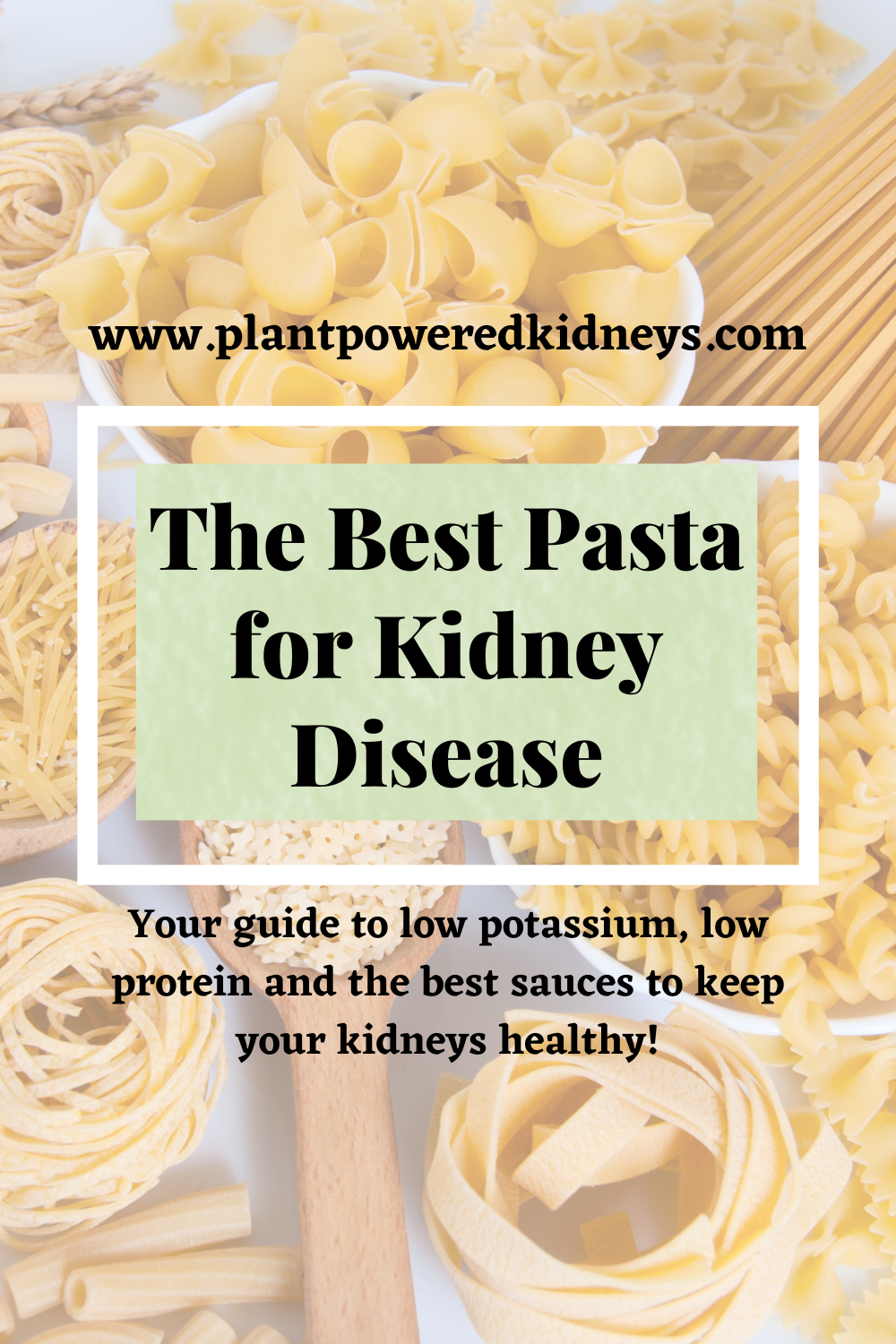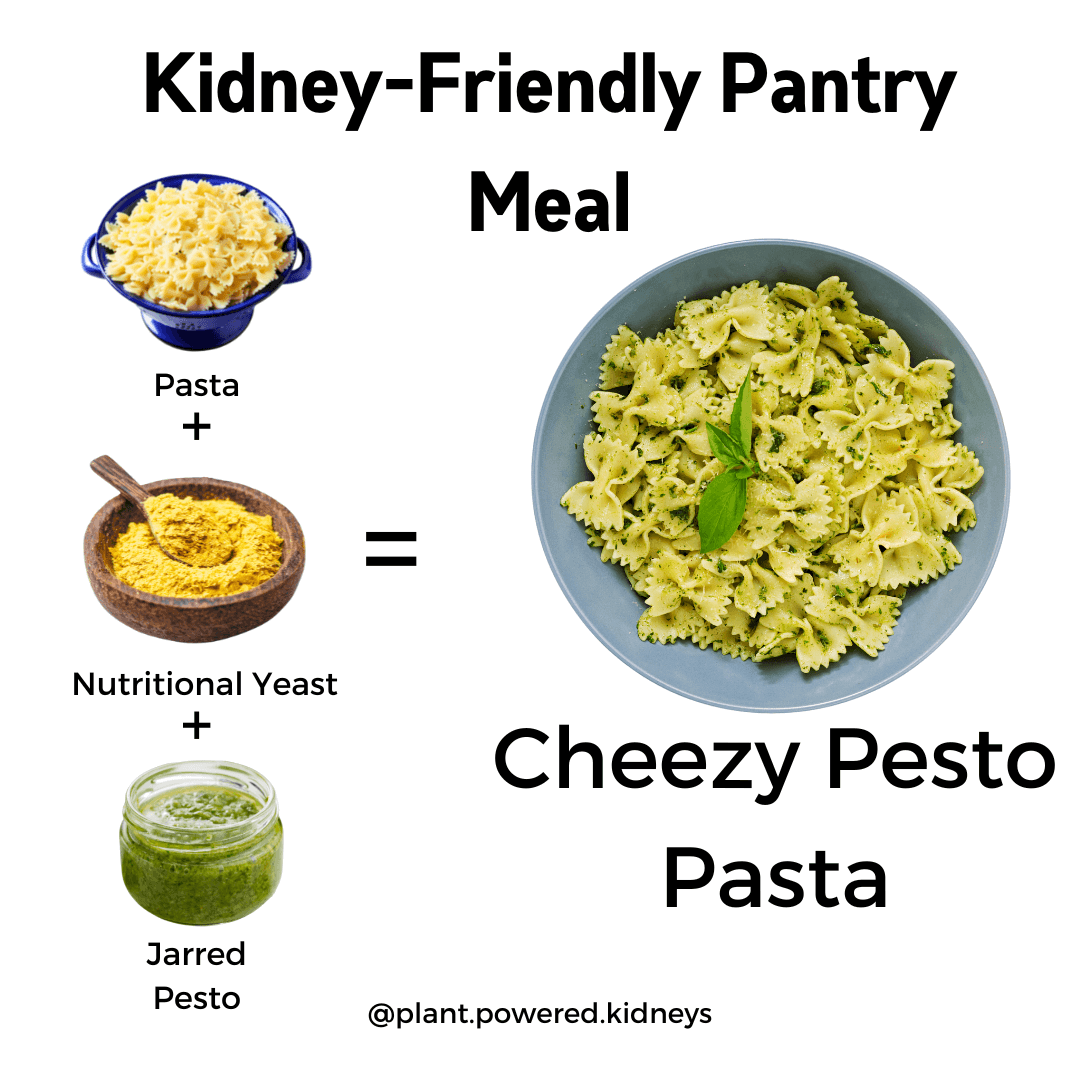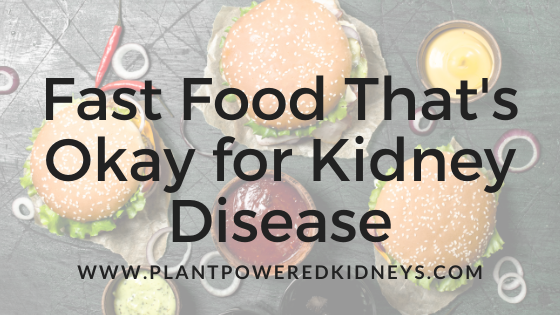Pasta is a common household staple across the globe. And nowadays it seems like there is an entire grocery store aisle dedicated to all of the different types of pasta available. But is pasta ok for kidney disease? What about the potassium in pasta? Which pasta is best for kidneys? This article will cover the amount of potassium in pasta types, high potassium pasta, low potassium pastas, and how to enjoy in a kidney-friendly diet.
Table of Contents
Why Is Potassium Important For Kidney Disease?
The main role of the kidneys are to filter out waste products. However, with kidney disease, poor filtration can lead to high levels of potassium in the body.
As kidney function declines, your healthcare team may suggest that you follow a potassium restriction. If so, ask your doctor or dietitian how much potassium you should eat in a day.
Potassium can also be too low. Therefore, it is important to get the right amount of potassium (and not aim for zero!).
What is considered high and low potassium?
A high potassium food will have more than 200 milligrams (mg) per serving.
However, it is considered to be a low potassium food if it has less than 200 mg of potassium per serving.
You can read more about potassium here.

The History of Pasta
Different cultures were making pasta thousands of years ago. It is safe to say that pasta has been a dietary staple for a very long time.
The first documentation of pasta so far dates back to the 4th century B.C. in the Etruscan civilization in Italy.
Chinese records show noodle variations popping up around 3000 B.C. Greek mythology also has records of early forms of pasta.
Pasta has been a staple across many different cultures and time periods, but can it fit into a low potassium diet? The answer is: maybe. Let’s find out why!
Different Types of Pasta
Pasta can be made from different flours or flour-alternatives and into many shapes and sizes.
In fact, there are actually about 350 different types of pastas.
Pastas are generally made from wheat flour mixed with water or eggs, then formed into the desired shape.
While wheat flour is the primary main ingredient of pasta, there are also alternatives available.
Pasta can also be made from:
- Rice
- Lentils
- Black beans
- Edamame
- Chickpeas
- Potato
Some types of pasta also add in vegetables like spinach or tomato to change the color and nutrition of the pasta.
Not only can pasta be made from different flours and bases. Pasta also comes in a variety of shapes and sizes.
Examples of types of pastas shapes include:
- Bow tie pasta (aka farfalle)
- Fettuccine
- Lasagna
- Bucatini
- Fusilli
- Linguine
- Ditaline
- Gemelli
- Macaroni
- Egg noodles
- Gnocchi
- Manicotti
- Angel Hair
- Tortellini
- Ziti
- Shell
- Rotelle
- Cavatappi
And that’s just to name a few.
Pasta Nutrition Breakdown
Grains, including pasta, can be a very nutritious part of your kidney friendly diet.
Pasta can provide loads of essential vitamins and minerals and can provide calories and fiber to your meal.
Adding in pasta and grains to a meal can also make your meal more filling and satisfying.
However, some pastas are higher in potassium than others. It may be important to look at the type of pasta you choose.
Nutrition in Pasta Comparison Table
Here is a table of different pasta nutrition facts, including calories, protein, potassium, carbohydrates, fiber, and iron.
| Pasta Type (Per 100g) | Calories | Protein (g) | Potassium (mg) | Carbohydrates (g) | Fiber (g) | Iron (mg) |
|---|---|---|---|---|---|---|
| Whole wheat, cooked | 149 | 6 | 96 | 30 | 4 | 2 |
| White Pasta, cooked, unenriched | 158 | 6 | 44 | 31 | 2 | 1 |
| Brown Rice Pasta | 138 | 3 | 25 | 32 | 2 | <1 |
| Egg Noodles, cooked | 138 | 5 | 38 | 25 | 1 | 1 |
| Shirataki Noodles, dry | 18 | 0 | 0 | 4 | 3 | <1 |
| Lentil Pasta, dry | 357 | 27 | 857 | 59 | 5 | 6 |
| Black Bean Pasta, dry | 357 | 21 | 1520 | 63 | 18 | 8 |
| Edamame Pasta, dry | 339 | 43 | 2300 | 35 | 25 | 20 |
| Rice Noodles, cooked | 107 | 2 | 4 | 24 | 1 | <1 |
| Udon Noodles, dry | 124 | 3 | 10 | 28 | 2 | 0 |
| Soba Noodles, cooked | 99 | 5 | 35 | 21 | varies | <1 |
All nutrition information obtained from the USDA nutrient database. Nutrition information may vary across different products.
Please look at individual product labels for more specific nutrition information.
The Best Pasta For Kidneys
In this next section, we’re going to break down into some of the best pasta options for kidney patients. This will depend on what your primary goal or focus is.
For example, you may need to find a low potassium option. Alternatively, you may need a high potassium option.
A low protein pasta may be more important if potassium is not a concern.

Low Potassium Pasta Options
When it comes to pasta, there are a ton of different low potassium options.
Remember to be mindful of portion sizes and to pair your pasta with low potassium veggies, proteins and fats to make it a complete meal.
Here is a list of low-potassium pastas per 100 gram serving that can fit into most renal diets.
- Whole wheat pasta – 96 mg
- White Pasta – 44 mg
- Shirataki Pasta (Pasta Zero, Nasoya Spaghetti Shape) – 0 mg
- Egg Noodles (unenriched) – 38 mg
- Rice Noodles – 4 mg
- Udon Noodles – 10 mg
- Soba Noodles – 35 mg

Moderate Potassium Pasta
Next we have pasta options with a moderate amount of potassium. This will be above a 200 milligram/serving threshold for low-potassium pasta options, but only slightly higher.
- Brown rice pasta – 273 mg
High Potassium Pasta
Next are the high potassium pasta options. These can fit into renal diets for those who are not on a potassium restriction or need to eat more potassium.
- Black Bean Pasta – 1,520 mg
- Edamame Pasta – 2,300 mg
- Fusilli Red Lentil Pasta – 857 mg
Although these bean and lentil pastas are very popular, they are very high in both potassium and protein.
For those needing a potassium restriction or low protein diet, it is best to avoid these.
Low Protein Pasta Options
Certain pastas can also be higher in protein.
Some people with kidney disease need to be mindful of the amount of protein that they consume.
Below are some low protein pasta options to include in your kidney-friendly diet:
- Shirataki Noodles – 0 grams (g)
- Rice Noodles – 2 g
- Egg Noodles – 5 g
- Udon Noodles -3 g
- Soba Noodles** – 5 g
**Certain soba noodle brands can be higher in protein. Be sure to check the individual product package label for exact amounts.
Pasta for Diabetes and CKD
If you have diabetes and kidney disease, you may need to be mindful of the amount of carbohydrates that you include in your meal.
Thankfully, there are plenty of lower carbohydrate, higher fiber options available.
Good Pasta Choices for Diabetes and Kidney Disease
Whole wheat pasta and shirataki pasta (pasta zero) can be some of your best options when choosing a diabetes and kidney-friendly pasta.
These two both have moderate amounts of carbohydrates and are good sources of fiber.
Looking for a low carbohydrate alternative to pasta? Try spaghetti squash. Whole grain pasta and spaghetti squash are both considered low potassium.
However, spaghetti squash has 5 g of carbohydrate in 1/2 cup.
In comparison, whole grain pasta has 21 g of carbohydrate per 1/2 cup.

Tips for Adding Pasta Into a Renal Diabetic Diet
- Add in a veggie to every pasta dish to add more fiber. Zucchini, carrots, squash and peas all go well (get our full list of low potassium fruits and veggies here).
- Include a side salad or side of steamed veggies.
- Choose smaller portion sizes of pasta and be sure to add in a source of fiber and fat.
- Take a walk after your meal. Just a ten-minute walk around the block can be a great way to bring blood sugars back down after a meal.
Pasta Sauces For Kidney Disease
Oftentimes, it’s not the pasta itself that makes a pasta dish higher in potassium. It is the sauce that makes it high in potassium.
Below are some great low potassium pasta sauces to round out your low potassium pasta meal and add some great flavor.
Low Potassium Pasta Sauce Options:
- Basil Pesto (many brands contain cheese, but vegan options are available)
- Works with all types of pastas
- Try this brand: Compagnia Sanremo Pesto*
- Pasta Aglio e Olio
- Great with whole wheat, lentil, and white pastas, as well as soba noodles
- Combine pasta with lemon, red pepper flakes, olive oil and parmesan cheese (optional)
- Sweet and Sour Sauce
- Great with udon noodles, shiratake noodles, and soba noodles
- Try this brand: La Choy Sweet and Sour Stir Fry Sauce*
- Thai Peanut Sauce
- Great with shiratake noodles, soba noodles, and udon noodles
- Try this brand: Thai Peanut Satay Sauce*
**Store-bought versions of these sauces are often higher in sodium. Therefore, be sure to use a smaller amount and make sure it fits into your sodium “budget” for the day.

High Potassium Kidney-Friendly Pasta Sauce
Below are some higher potassium pasta sauce options. If you need to follow a potassium restriction, it may be a better option to stick to the low potassium sauces listed above.
You may be able to add these pasta sauces into your kidney friendly diet if you don’t need to follow a potassium restriction.
- Tomato Based Store Bought Pasta Sauces
- Butternut Squash Pasta Sauce
- Burst Cherry Tomato Sauce
- Pumpkin Pasta Sauce
- Eggplant and Tomato Sauce
Tips For Adding in Pasta To Your Kidney-Friendly Diet
Now that we’ve covered the different types of pasta for kidney patients, let’s dive into more examples of how to add pasta to a kidney-friendly diet.
Choose higher fiber options
Fiber is essential for good heart health, digestive health and better blood sugar management. Therefore, it is very kidney friendly.
An item is a good source of fiber when it has 3 g of fiber or more per serving.
Whole wheat pasta and shirataki pasta are low potassium options that have at least 3 g of fiber per 100 g.
Take a look at how a low potassium pasta dish can fit into a high fiber day:

Be mindful of protein
Manufacturers will add protein to certain pastas (usually in the form of pea protein or chickpea and lentil flour).
For example, Barilla came out with a “Protein Plus” type of pasta that has pea protein as well as chickpea and lentil flour added to it.
This adds quite a bit of protein (10 g in a 2 oz serving of Protein Plus Angel Hair) and may not be the best option for kidney patients on a low protein diet.
Stick to the portion size
With pasta, it can be pretty easy to eat more than the suggested portion size.
Be sure to measure out the appropriate serving of pasta. In general, a pasta serving is about ⅓ cup.
For reference, 100 grams is approximately 1 cup of cooked pasta.
Make it a balanced meal
Make your pasta dish more balanced by adding in lean sources of protein (like garbanzo beans or pine nuts), a fat source and produce.
For example, use olive oil to saute onions, spinach, and garbanzo beans (chickpeas) to add to your plain pasta or pasta sauce.
Three Easy Pasta Recipes
Pressed for time? Keep these easy kidney-friendly pasta recipes on hand for a quick lunch or dinner.
Cheezy Pesto Pasta

Cook your favorite pasta and then add jarred pesto and nutritional yeast.
Make sure that your jarred pesto has less than 140mg of sodium per serving and no phosphorus additives.
Stir Fry Soba Noodles
Switch up your stir fry by using noodles instead of rice.
Cook shiratake, udon, or soba noodles according to package directions. Drain and set aside.
Add low potassium stir fry vegetables and tofu or edamame in a pan over medium heat. Cook for a few minutes before adding sweet and sour sauce.
Finish by tossing in cooked noodles and toss until everything is combined.
Pasta Salad
Toss a cooked pasta in a bowl with your favorite chopped low potassium veggies (bell peppers, scallions, shredded carrots and cucumbers all do great).
Drizzle of some low-sodium store bought Italian Dressing.
Add some feta or cubed tofu if you like.
Kidney Friendly Pasta Recipe
Ready to try out a new kidney friendly pasta recipe? This creamy lemon garlic pasta is sure to please!

Ingredients:
- 2 1/2 cups brown rice fusilli pasta
- 1 1/2 Tablespoons Extra Virgin olive oil
- 1 stalk green onion, chopped
- 1 garlic clove, minced
- 1/8 teaspoons red pepper flakes
- 1/2 cup hummus
- 1/2 lemon, juiced

Directions:
- Cook and drain pasta according to package directions, reserving some of the pasta water for later.
- Heat oil in a pan over medium heat. Add green onion and cook for 2 to 3 minutes.
- Add garlic and red pepper flakes. Continue to cook for one minute until fragrant.
- Remove pan from heat and stir in hummus and lemon juice.
- Stir in reserved pasta liquid, one tablespoon at a time, until desired consistency is reached.
- Add cooked pasta to the pan and toss until evenly coated.
- Serve and enjoy.
Recipe makes 4 servings
Nutrition Information (per serving)
- 472 calories
- 10 grams protein
- 281 milligrams potassium
- 78 milligrams phosphorus
- 176 milligrams sodium
Summary
With all of the types of pasta available, there is certainly one available that can fit into your kidney friendly diet.
If you need to follow a low potassium diet, finding a low potassium pasta may be easier than you think. Wheat pasta, shirataki pasta (Pasta Zero) and udon noodles are all great options to include.
Higher potassium pasta options include pastas made from legumes and beans, such as black bean pasta or lentil pasta. These options also are high in fiber and plant-proteins.
Add a low-potassium sauce or dressing such as pesto, olive oil with lemon, or even sweet and sour sauce for a flavor boost.
Whether you need low potassium, low protein or higher fiber options, there is a pasta option available to you. Bon Appetite!



I find this article very helpful as I am on dialysis, 18 years and counting.
Thank you for your kind words and support. Congrats on your kidney journey – dialysis is no easy feat! You must be doing a lot of great things to care for yourself. 💚
I am a type one diabetic with final stages of heart disease failure, I am also on dialysis, 3 times a week. I want to know what pasta to cover both potassium and reduced sugar levels
Hi Nick! Thanks for your question. We’ve added a column in the nutrition comparison table to include carbohydrates. Be sure to check out the section of the article about diabetes and kidney disease. Finally, you can ask your dialysis dietitian about pasta options that are best for you. I hope this helps. 💚
Hi Jen, Thank You for all the very informative help and recipe options! I am just getting in the game for fighting whatever level/situation/clearer explanation of what I need to do to do my best to care for my body, and I am looking for common denominators for my different conditions which co-contribute to each others conditions. Limiting some things and portion size while avoiding extremes seems to be the advice I hear. Processed foods need label reading to avoid all the added sodium, sugar, preservatives, refined, -far from natural state-foods. In a land where everything seems to be a scary place to walk, where even unprocessed fruits and veggies come with warning hints, it’s amazing when a meal, let alone a delicious one can be successfully delivered through the gauntlet, yet I see that this is indeed not only possible but very probable with hints like the basil and olive oil pesto sauce that can flavor so many things, even be a salad dressing!! Liked finding the pasta suggestions!!
Thank You very much again, also to thank your fellow kidney colleagues “Dr. Ro” and “Dadvice James” who I have also learned from by watching the videos.
Thank you so much, Leslie! Yes, there are a lot of things to consider with CKD. Hopefully we’re making it a little less scary and a little more enjoyable.